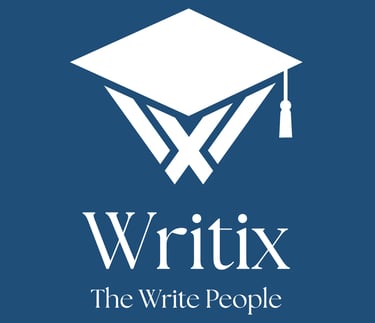How to Write a Strong Dissertation Introduction: Hook, Context, and Clarity
Learn how to write a compelling dissertation introduction that grabs attention, defines your research gap, and sets the tone for academic success.
DISSERTATION HELP
Dr. Kumkum
7/14/20253 min read


If starting your dissertation feels harder than the entire research process, you’re not imagining things. The introduction is the most-read and most-judged section of your entire work, it’s where you make your first impression on your supervisor or reviewers. A strong introduction is not only about telling the reader what the dissertation is about; it's about convincing them why it matters and why you’re the one to write it.
In this step-by-step guide, we’ll help you craft a compelling introduction that sets the tone, defines the purpose, and lays the groundwork for everything that follows. Whether you’re stuck at square one or polishing your final draft, this guide will help you hit the right academic notes. And if you're overwhelmed, remember that our dissertation writing services are just one click away.
1. Start With a Hook: Why Should Anyone Care?
You don’t need to be poetic, but you do need to be purposeful. Your first few lines should pull the reader in. Consider:
A startling statistic
A real-world dilemma
A provocative quote
A gap in existing research
Example:
“Despite the rapid digitization of education, over 40% of public school teachers report feeling underprepared to use technology effectively in classrooms (Smith, 2023).”
This kind of opening immediately signals relevance, urgency, and domain awareness.
Want help crafting an impactful hook? Try our expert dissertation help for tailored writing support.
2. Establish the Context
Once you've captured interest, zoom out. What’s the background of the issue? What academic or practical contexts does it sit within?
Here you should include:
Field-specific background
Ongoing debates or controversies
Any recent developments
This builds the foundation for your research gap, which is your next step.
3. Identify the Research Gap and Justify Your Study
This is arguably the most important part of your introduction. You’re answering:
“What hasn’t been done—and why does that matter?”
Be specific. Avoid vague claims like “few studies exist.” Instead, say:
“While several studies have explored online learning in higher education (e.g., Taylor, 2019; Kumar, 2021), little attention has been paid to how these platforms impact student engagement in community colleges.”
This shows critical insight, and is a key reason many students seek dissertation assistance to sharpen this section.
4. Define Your Aims, Objectives, and Research Questions
You’ve explained the problem, now state your goals.
Aim: Your overall goal
Objectives: How you’ll achieve the aim
Research Questions: The key questions your dissertation will answer
Example:
Aim: To evaluate the impact of hybrid learning models on student engagement in UK community colleges.
Objective 1: To measure engagement metrics before and after the implementation of hybrid models.
Research Question: How has the introduction of hybrid learning influenced student participation in academic activities?
Make sure your objectives are measurable and achievable, and that your questions align with your methodology.
5. Clarify the Scope and Limitations
Readers need to know what you’re covering—and what you’re not. This shows your academic maturity and prevents criticism for things outside your focus.
Example:
“This study focuses exclusively on first-year undergraduate students in public community colleges in the UK. It does not examine postgraduates or private institutions.”
This is where many students struggle with clarity and end up needing PhD dissertation help to fine-tune the details.
6. Define Key Terms and Concepts
If your dissertation uses complex or field-specific terminology, define it early. This ensures the reader can follow your logic throughout.
Terms like "engagement," "retention," or "digital pedagogy" mean different things in different disciplines. Be precise and reference established definitions.
7. Outline the Structure of Your Dissertation
Close your introduction with a short paragraph explaining what each chapter will cover. This helps orient the reader and sets expectations.
Example:
“Chapter 1 provides an overview of the research problem and objectives. Chapter 2 critically reviews existing literature. Chapter 3 details the methodology, while Chapter 4 presents findings. Chapter 5 discusses implications, and Chapter 6 concludes with key recommendations.”
Common Mistakes to Avoid in Dissertation Introductions
Being too general – Phrases like "education is important" are weak without context.
Failing to show originality – Supervisors want to see how your work adds value.
Neglecting research questions – These guide your whole dissertation—don't skip them.
Too much background – Save the deep theory for the literature review.
Avoid these pitfalls by working with a professional thesis writer who understands both clarity and academic standards.
Final Thoughts: Set the Tone for a Winning Dissertation
Your introduction isn’t just an opener, it’s your chance to make a statement. A strong start shows you're in control of your topic, you understand your field, and you have something meaningful to contribute.
Still struggling with where to begin? Let Writix take the pressure off. From the opening line to the final conclusion, our dissertation writing help ensures your work starts strong and finishes stronger.
Address: Writix, Level - 5, The Iconic Corenthum, Tower- C, A-41, Sector 62, Noida, Uttar Pradesh 201301
Phone : +91 9289469111
2025 Thewritix. All Rights Reserved.
Blogs
Social
Research Consultation Services
Journal Publishing Assistance


We Accept

Add On Services
Who we are?
Our Team
